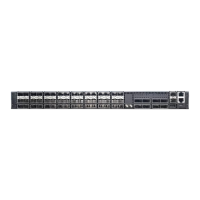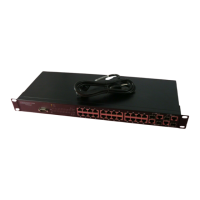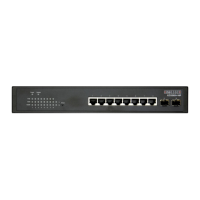Chapter 18
| VLAN Commands
Configuring VXLAN Tunneling
– 497 –
show
l2protocol-tunnel
This command shows settings for Layer 2 Protocol Tunneling (L2PT).
Command Mode
Privileged Exec
Example
Console#show l2protocol-tunnel
Layer 2 Protocol Tunnel
Tunnel MAC Address : 01-12-CF-00-00-00
Interface Protocol
----------------------------------------------------------
Eth 1/ 1 Spanning Tree
Console#
Configuring VXLAN Tunneling
This section describes the commands used to configure Virtual Extensible LAN
(VXLAN) tunneling.
VXLAN is a networking scheme that encapsulates MAC-based Layer 2 Ethernet
frames within Layer 3 UDP packets to aggregate and tunnel multiple layer 2
networks across a Layer 3 infrastructure. VXLAN scales up to 16 million logical
networks and supports Layer 2 adjacency for isolated tenants across IP networks.
Multicast transmission is used for broadcast, multicast, and unknown unicast traffic.
In this implementation, broadcast, multicast and unknown unicast traffic can also
use unicast tunneling.
When a packet enters a switch port, the switch determines if the VLAN to which this
port belongs is associated with a VXLAN ID. If a VLAN to VXLAN mapping is found, it
then searches the bridge table for the destination port. If the egress port is found,
the packet is encapsulated with a VXLAN header and sent on to the corresponding
VTEP. If the egress port is not found, the packet is flooded to all VTEPs on this
VXLAN ID. The flooded packet may encapsulated as a unicast packet or multicast
packet according to the configured setting as described in RFC 7348.
Unicast VM-to-VM Communication
Consider a VM within a VXLAN overlay network. To communicate with a VM on a
different host, it sends a MAC frame destined to the target as it normally would. The
VTEP on the physical host looks up the VNI to which this VM is associated. It then
determines if the destination MAC is on the same segment and if there is a
mapping of the destination MAC address to the remote VTEP. If so, an outer header
comprising an outer MAC, outer IP header, and VXLAN header are prepended to the
original MAC frame. The encapsulated packet is forwarded towards the remote
VTEP. Upon reception, the remote VTEP verifies the validity of the VNI and whether
or not there is a VM on that VNI using a MAC address that matches the inner
destination MAC address. If so, the packet is stripped of its encapsulating headers
and passed on to the destination VM.
